
Sturt's desert pea, Alice Springs Desert Park
[ < < previous | index | next >> ]
We're waiting for our clothes to dry after a busy but more relaxing morning here in Alice Springs.
We slept in until 08:00 to help overcome the exhaustion of the past few days. After a breakfast of Weet Bix, we made some bread rolls with Jarlsberg cheese and one with Vegemite for lunch. Then we drove the short distance a few kilometres west of town to the Alice Springs Desert Park.
 Sturt's desert pea, Alice Springs Desert Park |
This park showcased a variety of desert landscapes: bushland forest, sand dunes, and desert rivers. Each had a section of land devoted to it, showing the typical vegetation of the associated ecosystem. Large aviaries contained birds from each region, and a lot of the same species could also be seen wild amongst the outside foliage. The aviaries also contained some reptiles and small marsupials.
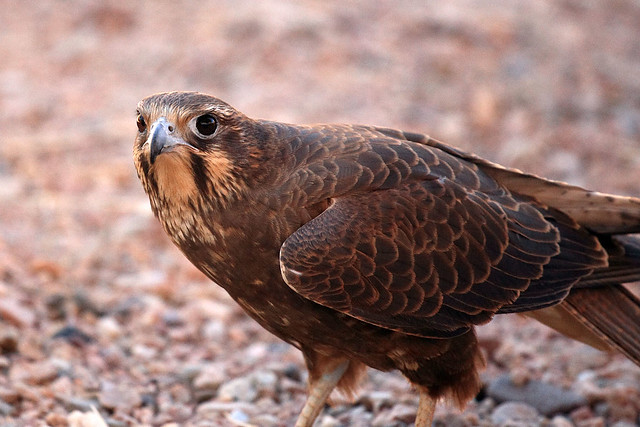 Brown falcon, Alice Springs Desert Park |
A highlight was the live Birds of Prey show. Done twice a day, this was a 20-minute talk by a guy about the desert habitats and the various animals who live in them. At intervals throughout the talk, birds of appropriate species flew in and posed and swooped for us. He fed them, but otherwise they were free flying. There was a magpie, a brown falcon, a boobook owl, a butcher bird, and one or two others. Some of them swooped very close to the audience as he tossed bits of meat out over us for the birds to catch and eat on the wing. At one point, an eagle flew so close to the presenter that it hit him in the face with an outstretched wing.
 Whistling kite, Alice Springs Desert Park |
We've just returned from dinner, but back to earlier:
There were also enclosures with red kangaroos and emus - but they stayed a far from the paths as they could so it was tricky getting glimpses of them through the shrubs. The other highlight was the nocturnal house, where we saw lots of shy little desert marsupials, such as the rufous hare-wallaby, and tiny rat kangaroos, as well as various snakes and lizards, and even a ghost bat. The best thing there was a thorny devil, which was amazingly spiky and quite active, wandering around its little glass enclosure without stopping while we were watching. And its colours were striking too - bright yellow and orange stripes with more subdued brown shades interspersed.
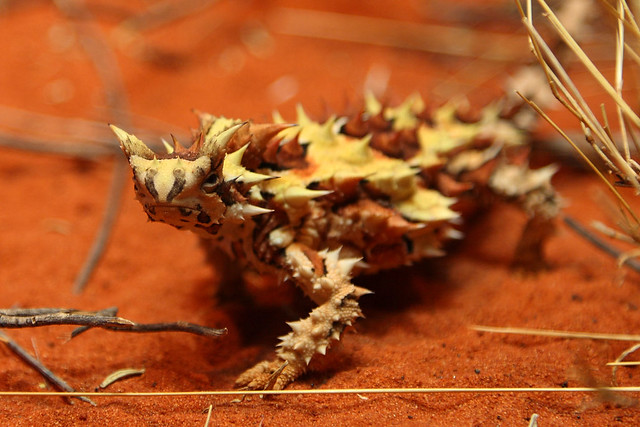 Thorny devil, Alice Springs Desert Park |
The weather was a cool 20° or so, but the sky was again cloudless and the sun burned down relentlessly, making the walk through the park hot work. We finished just after noon and raced back to the car to get some of our bread rolls for a quick lunch.
Next was the Alice Springs Cultural Precinct, which is a collection of artistic, scientific, and cultural museums within a single area connected by short walks. We began with the Araluen Arts Centre, which contained an exhibit of entries into the most recent Beanie Festival - an annual competition which is apparently extremely popular here, attracting entries of creatively designed and fashioned beanies from all over Australia and overseas. It also held a gallery of watercolour landscapes by Albert Namatjira and various of his relatives, and some desert wildlife studies in acrylics by some other artists - very detailed and lifelike. There was also a travelling exhibition of Australian landscape paintings from the National Gallery and the New South Wales Art Gallery. We'd seen many, if not most, of these paintings before in their home galleries - works by McCubbin, Streeton, Boyd, Rees, Nolan, Heysen, and others.
The next stop in the precinct was Central Craft. We thought this would be quite good, but it was actually a little disappointing, being rather bland craftworks by European Australians. Nothing indigenous at all. There was a large workshop which might have been good to walk through, seeing people at work actually making craft items, but that was closed for a tour group so they didn't let us go on.
Next was the Museum of Central Australia. Although a fairly small museum, it contained some fascinating exhibits. It began with a downstairs section containing a timeline that began with the Big Bang, progressing quickly on display panels through galaxy and star formation, up to the point where meteoroids bombarded the early Earth. This section contained photos of various impact craters scattered across Australia and samples of meteoric material including part of the famous Murchison Meteorite and a case full of tektites.
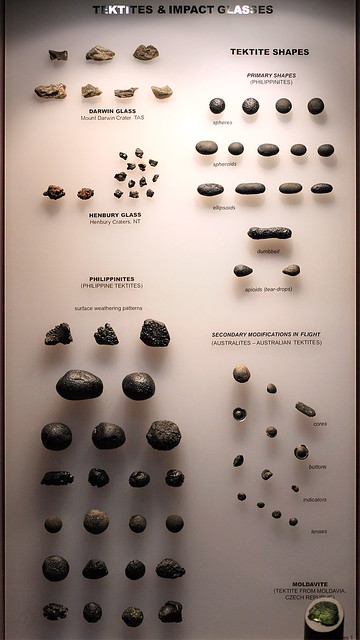 Tektites, Museum of Central Australia |
One iron meteorite from the Henbury Meteorites Conservation Reserve was cut and polished, showing a gleaming mirror-like finish, next to the pitted and dull natural surface covering the rest of the sample. Another one was cut and etched, showing the 120° triangular Widmanstätten patterns formed as the iron cooled and crystallised during the meteoroid's formation.
 Henbury meteorite, Museum of Central Australia |
The displays moved on to geology - showing the various rock formations and strata of the central Australian region. Then life appeared, with displays of West Australian stromatolites, followed by trilobites, ancient armoured fish, and other things, all illustrated with relevant fossils. This sequence ended at a giant moa skeleton mounted in the centre of the room, followed by a large section showing modern animals, both stuffed in display cases and also several as mounted skeletons.
Near the ramp back upstairs was a display of minerals with various of the prettier varieties shown. Up the ramp was a display on the pioneering central Australia anthropologist Ted Strehlow and his wife Bertha. They took a four month "honeymoon" on a camel trek across the middle of the country in the 1930s studying the local Arrernte people. The trip turned into a nightmare when Bertha miscarried early in a pregnancy and lay stricken and unable to be moved in the middle of nowhere. She was only saved because a tribe of Aborigines found them and their healing women managed to stop her bleeding and nurse her back to health. A TV showed some of the film that Ted had taken on the expedition.
Near this display were some of the Aboriginal artefacts Strehlow had collected in his career. The Strehlow Research Centre housed in the same building continues his anthropological research today.
The next thing in the Cultural Precinct was the memorial built to house the wreck of the Kookaburra - the tiny two-man plane sent out to search for the lost aviator Charles Kingsford Smith in the desert. The Kookaburra itself crashed in the Tanami Desert and its crew were never found, but Kingsford Smith and his navigator were rescued by other searchers. The Kookaburra remained lost until spotted from the air in 1979. The tiny fuselage in the memorial shows just how brave the early aviators were to face the implacable Australian desert in these small and fragile planes.
Beyond the memorial was the Central Australian Aviation Museum, housed in an old hangar, containing an old DC-3 which had been flown by the historical Connellan Airways - the first airline to open up access to the Australian Outback. There was also a smaller plane - it looked like a small WWII bomber to my untrained eyes - and several engines, propellers, old photos, flags, and other early aviation memorabilia.
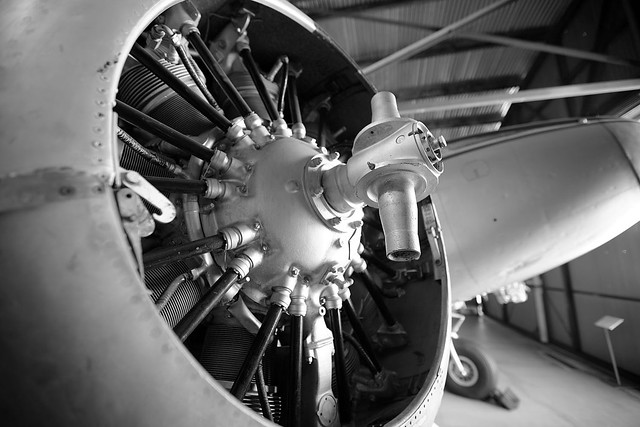 Central Australian Aviation Museum |
Finally, the precinct adjoined the historical Alice Springs Memorial Cemetery. This was a dusty and dry plot of land, with not a speck of grass to be seen on the red dirt, which was marked only by the scattered gravestones and a few itinerant trees. This cemetery contains the remains of Harold Lasseter - of the golden reef fame - he died in the desert seeking what would become the almost mythical Lasseter's Reef - a huge deposit of gold that he had reported finding on a previous expedition but had jealously guarded by not revealing its exact location to anyone. His remains were found decades later and interred in the cemetery under a large terracotta sculpture of the man panning for gold. It's rather ironic that Alice Springs' casino is named Lasseter's, after a man who died seeking what was possibly an illusionary easy fortune.
The cemetery's most famous resident however, is Albert Namatjira, buried beneath a great sandstone block bearing a square of nine porcelain tiles painted with a landscape reminiscent of his own distinctive watercolours.
By now we were quite hot in the middle of the day sun. We walked back to the car and had a welcome drink of water. We drove back to our room and collected our dirty laundry to take to the laundromat to wash. While letting it wash, we went a few doors down to a backpackers' hostel and used a net terminal for 20 minutes.
Laundry done, we returned via the nearby K-Mart to get some swimming goggles for me and some extra pens for diary writing, and Coles supermarket to get more food supplies for the road. Then we returned to our room briefly and I had a good long swim in the hotel pool before heading out to ANZAC Hill for the sunset view over Alice and the MacDonell Ranges. The hill was busy with people admiring the view and the sunset, taking photos and so on.
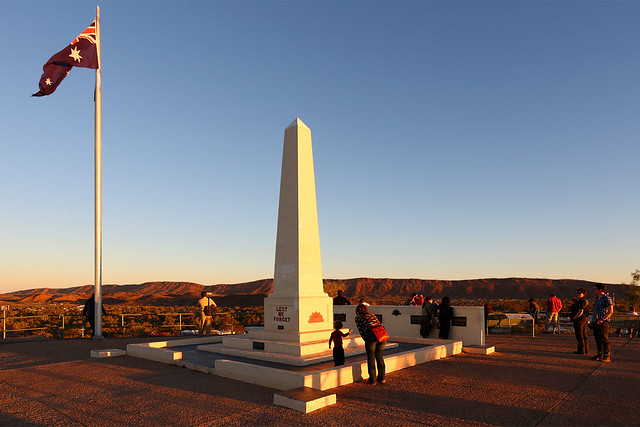 ANZAC Hill |
After the sunset, we travelled back down into the centre of town and had dinner in the Thai Room - a cheap and cheerful Thai restaurant. M. had a spring roll followed by stir fried veges and cashews, while I had a curry puff and massaman beef curry. We figured some Thai food would be good before we head off into the wilderness where the menus will be a lot less varied for the next few days. On the way home I picked up an Ecuadorian cocoa dark chocolate Magnum ice cream from a nearby pizza and kebab joint
 Dinner at Thai Room |
Now we're relaxing and watching the extra innings bronze medal cliffhanger Olympic softball game between Australia and Japan before we go to sleep.
One more thing before signing off for the night - the local radio station "Territory FM" is awesome. It's the sort of radio station you only find in the country. It plays a cross section of music from the 50s all the way through to the present day. We've heard Sinatra, Meatloaf, Springsteen, The Thompson Twins, Split Enz, U2, Smashmouth, Chris Connell, Dolly Parton(!), and a bunch of others - all on the one station. No station in Sydney would have a selection anywhere near that broad.
[ < < previous | index | next >> ]